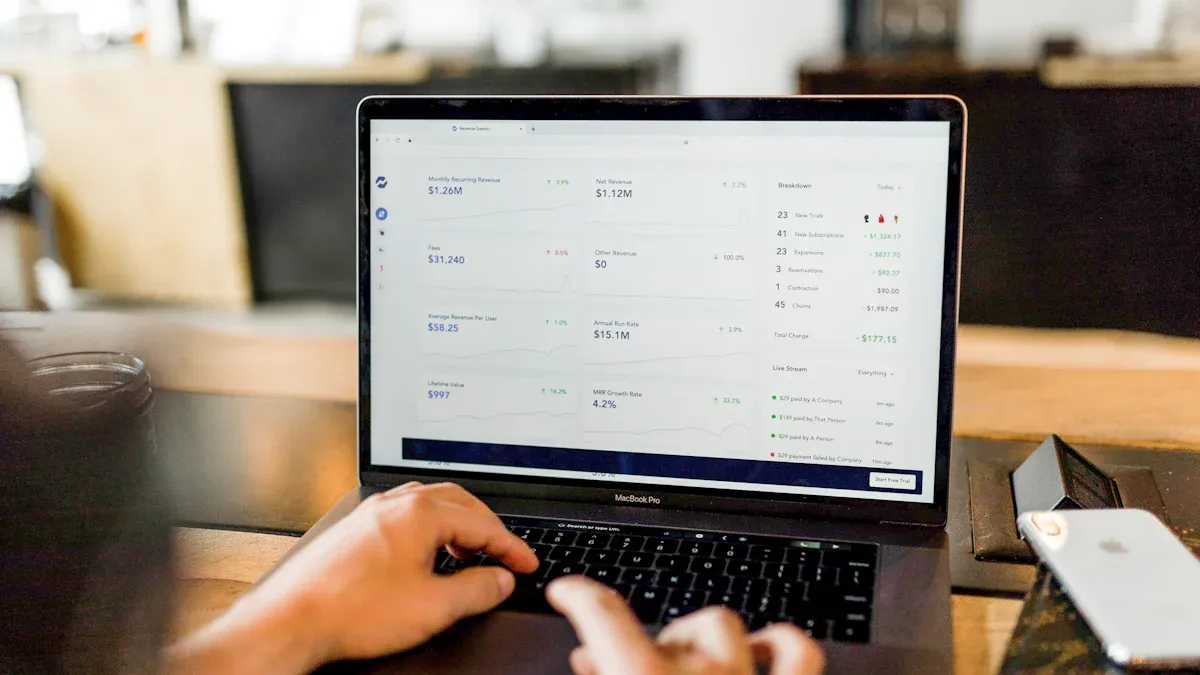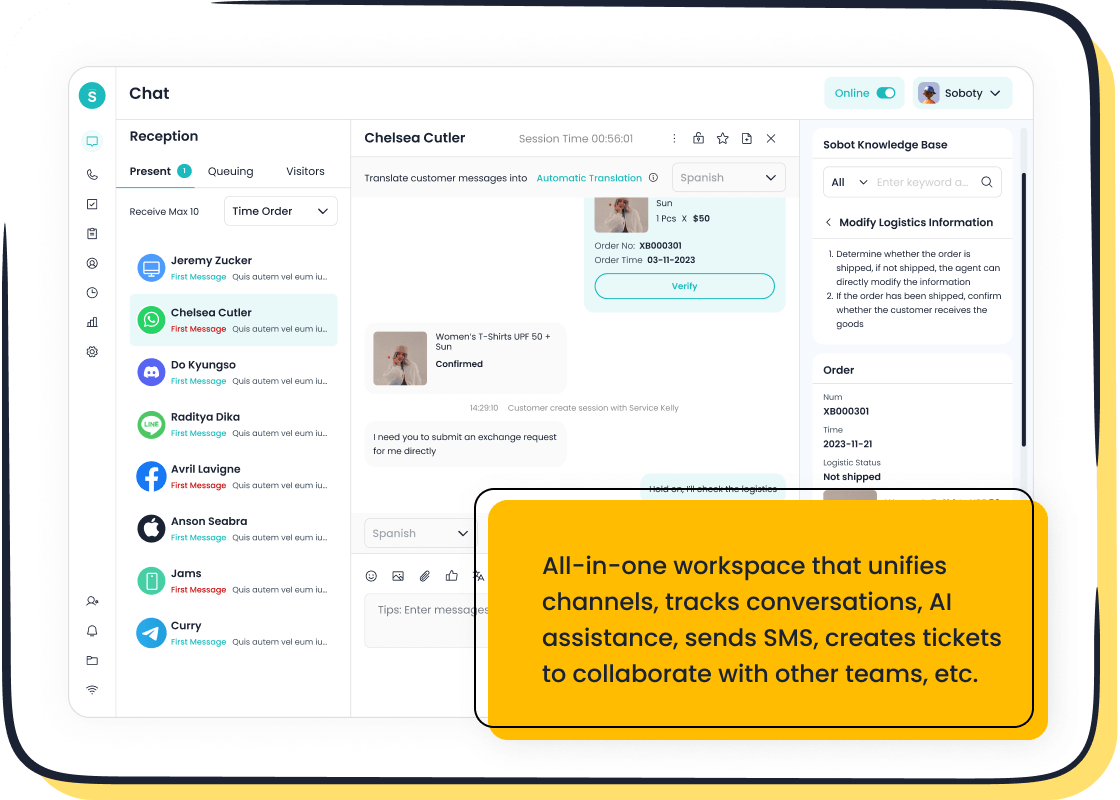Five Reasons Customer Churn Is the Most Important Metric for Your Company

Customer churn stands as the most critical metric for measuring business health and business growth. The churn customer meaning refers to the percentage of clients who stop using a company’s products or services during a specific period. In customer contact and support, businesses track churn by calculating lost customers over time. The impact of customer churn reaches every part of an organization. Losing just 5% of customers can lead to a 25% to 95% drop in profits, while 67% of churn could be avoided with better first-contact resolution. Customer churn not only affects revenue but also lowers customer satisfaction and increases operational costs. Sobot helps companies reduce customer churn with solutions like Live Chat, which improve customer experience and drive retention.
Understanding Customer Churn
Churn Customer Meaning
Understanding customer churn is essential for any business that wants to grow and succeed. The churn customer meaning refers to the rate at which customers end their relationship with a company or cancel their subscription to its products or services. This metric helps businesses see how many customers leave over a certain period. For example, if a company starts the month with 4,000 customers and loses 200, the churn rate is 5%. Companies in industries like banking have found that customer churn can cause major revenue loss and even affect how potential customers view the brand. Research shows that keeping existing customers costs much less than finding new ones—retention is five to six times more cost-effective than acquisition. Sobot’s Live Chat and analytics tools help businesses understand the key factors behind customer churn by tracking customer interactions and satisfaction scores.
Note: Cohort analysis and RFM analysis are two common ways to study churn. Cohort analysis groups customers by shared traits and tracks their behavior over time. RFM analysis looks at how recently and often customers buy, and how much they spend. These methods help companies spot common triggers of customer churn and focus on the most valuable groups.
Customer Churn Rate
Customer churn rate is a simple but powerful metric. It is calculated by dividing the number of customers lost during a set period by the total number of customers at the start, then multiplying by 100. This percentage shows how well a business keeps its customers. For subscription businesses, a healthy monthly churn rate is usually between 3% and 5%. Lower Net Promoter Scores (NPS) and Customer Satisfaction Scores (CSAT) often predict higher churn. Sobot’s built-in analytics let companies track these numbers in real time, making it easier to spot common triggers of customer churn and take action quickly. By understanding customer churn, support teams can improve service and reduce the risk of losing customers.
Revenue Impact of Customer Churn

Lost Revenue
Customer churn has a direct impact on a company’s bottom line. When customers leave, businesses lose not only their current revenue but also future earnings from those relationships. For example, Netflix lost 4% of its U.S. subscribers, which led to an $8 million monthly revenue loss. Blue Apron’s high customer churn rates shortened customer lifetime value from 26 months to just 6 months, causing a $210 million net loss in 2017. BlackBerry faced a $1.1 billion net loss and a 70% drop in stock price due to churn, which eventually forced it out of the smartphone market. These cases show how the impact of customer churn can threaten a company’s survival.
Long-term customers spend 67% more than new ones, according to Bain & Company. Retaining just 5% more customers can increase profits by 25% or more. Losing high-value customers can cause revenue churn rates to exceed customer churn rates, making the financial impact even greater.
Sobot’s customer story with OPPO highlights how reducing churn can drive growth. OPPO used Sobot’s solutions to improve customer service, resulting in a 57% increase in repurchase rate and a 94% positive feedback rate. This shows that efforts to reduce customer churn can lead to higher revenue and customer loyalty.
Cost of Acquisition
High customer churn rates force companies to spend more on acquiring new customers. The cost of replacing lost customers often exceeds the cost of keeping existing ones. Research shows that increasing customer retention by just 5% can boost profits by up to 95%. Retention strategies have saved companies millions in potential lost revenue, such as $2.1 million in prevented churned revenue in one quarter.
Sobot helps businesses reduce churn by providing tools like Live Chat, which improve customer experience and increase satisfaction. By focusing on retention, companies can lower acquisition costs and protect their revenue streams.
Customer Lifetime Value and Churn
Churn Rate Effect
Customer churn directly shapes customer lifetime value. When a business faces a high churn rate, the average customer stays for a shorter period. The customer lifetime is the inverse of the churn rate. For example, if a subscription company has a churn rate of 10%, the average customer lifetime is ten months. Lowering churn increases the time customers remain, which boosts lifetime value. Harvard Business Review reports that a 5% increase in retention can raise profits by 25% to 95% (source). This strong link shows that reducing churn is vital for long-term success. Loyal customers spend more and try new products, while returning customers generate three times more revenue than first-time buyers. Companies that focus on customer retention and reduce customer churn see the long-term benefits of reducing customer churn, including higher revenue and stronger brand loyalty.
Tip: Tracking churn rate and customer retention helps businesses spot problems early and take action to protect lifetime value.
Sobot Live Chat for Retention

Sobot Live Chat helps businesses reduce customer churn and increase customer retention. The platform uses AI-driven analytics to understand customer needs and deliver fast, personalized support. Companies using Sobot Live Chat have seen a 38% increase in conversion rates and a 57% rise in repurchase rates. These results show the long-term benefits of reducing customer churn and the impact on lifetime value. Sobot’s omnichannel support ensures no missed conversations, which keeps customers engaged and satisfied. Features like live agent handoff, chatbots, and advanced analytics help businesses maintain a low churn rate and build lasting relationships. Subscription businesses especially benefit from these tools, as they rely on continuous engagement for long-term success. Sobot’s solutions support continuous improvement for sustainable growth and help companies achieve the long-term benefits of reducing customer churn.
Churn as a Business Health Indicator
Early Warning Signs
Monitoring customer churn gives companies early signals about their overall business health. When the churn rate rises, it often points to deeper issues such as poor customer satisfaction or product problems. Companies track several key metrics to spot these warning signs:
- Customer sentiment signals like Net Promoter Score (NPS), Customer Satisfaction (CSAT), and product reviews
- Financial signals such as recurring revenue, payment failures, and contract renewals
- Operational signals including onboarding completion and feature usage
- Demographic signals like company size and industry
A sudden drop in product usage or a spike in support tickets can signal that customers may soon leave. For example, a multinational supplier used AI to analyze over 50 customer behaviors. By acting on early churn signals, the company saved $40 million each year. Companies that respond quickly to these signs can prevent customer churn and protect their revenue. Poor customer health often leads to higher churn, lost revenue, and increased support costs, which can seriously impact business performance.
Tip: Regularly review customer health scores to catch problems before they grow.
Sobot Analytics
Sobot provides advanced analytics that help businesses track and understand customer churn in real time. The platform collects data from every customer interaction, including chat, calls, and support tickets. Sobot’s analytics dashboard displays key metrics like churn rate, NPS, and CSAT, making it easy for managers to spot trends and take action. Companies can set up real-time alerts for early warning signs, such as drops in engagement or rising complaints. By using Sobot’s analytics, businesses can quickly identify at-risk customers and launch targeted retention campaigns. This proactive approach reduces churn and supports continuous improvement for sustainable growth. Sobot’s tools help companies maintain strong customer relationships and ensure long-term business health.
Strategies to Reduce Customer Churn

Proactive Engagement
Companies that want to lower customer churn must act before problems arise. Proactive engagement means reaching out to customers, not waiting for them to complain or leave. Research shows that proactive strategies can increase retention rates by 15-20% and improve customer satisfaction. Businesses often use automated alerts to spot drops in engagement, then follow up with personalized messages or offers. Regular check-ins, structured onboarding, and predictive analytics help companies understand customer needs and prevent churn. Nick Mehta, CEO of Gainsight, notes that waiting for customers to express dissatisfaction is too late. Companies must anticipate needs and act early.
Effective strategies to reduce customer churn include:
- Analyzing feedback from exit interviews and support tickets to find friction points.
- Using AI tools to detect hidden patterns in customer feedback.
- Mapping the customer journey and providing clear onboarding.
- Personalizing communication based on customer behavior.
- Monitoring engagement metrics and setting alerts for low activity.
- Offering loyalty programs and milestone rewards.
- Providing omnichannel support with fast response times.
Note: 44% of customers leave because their desired outcomes are not met. Delivering clear value and maintaining open communication are key to customer retention.
Sobot Solutions
Sobot offers advanced tools that help businesses implement effective churn management strategies. Sobot Live Chat provides omnichannel support, allowing companies to connect with customers on their preferred platforms, such as WhatsApp, Facebook, and websites. The platform uses AI-driven analytics to monitor engagement and identify at-risk customers. Businesses can personalize interactions, send targeted offers, and respond quickly to inquiries, all from a unified workspace.
Sobot’s marketing solution enables companies to launch re-engagement campaigns and reward loyal customers. With built-in analytics, businesses can measure success in reducing customer churn and adjust their approach for better results. Sobot’s solutions help companies improve customer experience, boost retention, and build lasting customer loyalty.
Customer churn remains the most important metric for any company.
- High customer churn leads to lost revenue, increased costs, and lower customer satisfaction.
- Tracking churn helps companies measure customer retention, predict risks, and support long-term success.
- A focus on customer churn drives business growth by improving customer lifetime value and brand reputation.
- Companies like Sobot use advanced analytics and AI to monitor churn, enabling proactive strategies for long-term success.
- Reducing customer churn ensures long-term success and supports continuous improvement.
Companies that prioritize customer churn analysis and invest in solutions like Sobot Live Chat see stronger customer retention and sustainable business growth.
FAQ
What is customer churn and why does it matter?
Customer churn measures the percentage of customers who stop using a company’s services during a set period. High churn rates signal problems with customer satisfaction. Companies that focus on reducing churn see higher profits and better customer loyalty. Sobot helps businesses track churn for continuous improvement for sustainable growth.
How can businesses reduce customer churn effectively?
Businesses reduce churn by improving customer service, offering personalized experiences, and using proactive engagement. Sobot’s Live Chat and analytics tools help companies identify at-risk customers and respond quickly. These strategies support continuous improvement for sustainable growth and help companies retain more customers.
Why is tracking customer churn important for business health?
Tracking churn provides early warnings about customer dissatisfaction or product issues. Companies that monitor churn can act fast to fix problems. Sobot’s analytics dashboard gives real-time insights, supporting continuous improvement for sustainable growth and helping businesses maintain strong customer relationships.
How does Sobot support continuous improvement for sustainable growth?
Sobot offers omnichannel support, AI-driven analytics, and marketing solutions. These tools help businesses engage customers, measure satisfaction, and launch targeted campaigns. By using Sobot, companies achieve continuous improvement for sustainable growth and build lasting loyalty.
Can reducing churn increase customer lifetime value?
Yes. Lower churn means customers stay longer and spend more. For example, a 5% increase in retention can boost profits by up to 95% (source). Sobot’s solutions help companies extend customer lifecycles, supporting continuous improvement for sustainable growth.
See Also
Best Voice of Customer Tools Reviewed and Compared
Ten Ways To Improve Customer Satisfaction Through Live Chat
Leading Voice of Customer Software Solutions For 2024
Effective Strategies To Enhance Call Center Performance Monitoring
